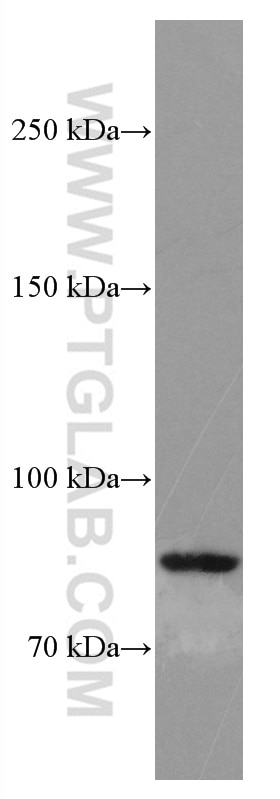Validation Data Gallery
Tested Applications
| Positive WB detected in | MCF-7 cells |
Recommended dilution
| Application | Dilution |
|---|---|
| Western Blot (WB) | WB : 1:1000-1:6000 |
| It is recommended that this reagent should be titrated in each testing system to obtain optimal results. | |
| Sample-dependent, Check data in validation data gallery. | |
Product Information
66874-1-Ig targets SMYD4 in WB, ELISA applications and shows reactivity with Human samples.
| Tested Reactivity | Human |
| Host / Isotype | Mouse / IgG1 |
| Class | Monoclonal |
| Type | Antibody |
| Immunogen | SMYD4 fusion protein Ag11552 相同性解析による交差性が予測される生物種 |
| Full Name | SET and MYND domain containing 4 |
| Calculated molecular weight | 804 aa, 89 kDa |
| Observed molecular weight | 85-89 kDa |
| GenBank accession number | BC035077 |
| Gene Symbol | SMYD4 |
| Gene ID (NCBI) | 114826 |
| RRID | AB_2882208 |
| Conjugate | Unconjugated |
| Form | Liquid |
| Purification Method | Protein G purification |
| UNIPROT ID | Q8IYR2 |
| Storage Buffer | PBS with 0.02% sodium azide and 50% glycerol , pH 7.3 |
| Storage Conditions | Store at -20°C. Stable for one year after shipment. Aliquoting is unnecessary for -20oC storage. |
Background Information
SMYD4, also named as SET and MYND domain-containing protein 4, is a 804 amino acid protein, which contains 1 MYND-type zinc finger and 1 SET domain. SMYD4 belongs to the class V-like SAM-binding methyltransferase superfamily. SMYD4, as a potential tumor suppressor, plays a critical role in breast carcinogenesis at least partly through inhibiting the expression of Pdgfr-alpha, and could be a novel target for improving treatment of breast cancer. SMYD4 is a muscle-specific transcriptional modulator involved in development.
Protocols
| Product Specific Protocols | |
|---|---|
| WB protocol for SMYD4 antibody 66874-1-Ig | Download protocol |
| Standard Protocols | |
|---|---|
| Click here to view our Standard Protocols |
